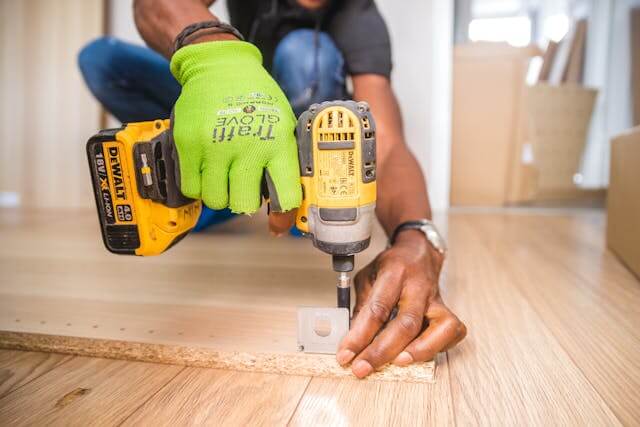Non-residential buildings
Obligation to renovate
Ever since 1 January 2022, those who own a non-residential building, are holders of a right to build a non-residential building, or have an emphyteusis on a non-residential building in Flanders—such as offices, hotels, restaurants, catering facilities, and retail space or property—have a duty to renovate that type of property. Within five years from when the authentic deed pertaining to the non-residential building was executed, all necessary renovation works must be carried out in order to attain the following energy performance levels:
- Minimum roof insulation: if, at the time when the authentic deed is executed, the roof insulation does not have a minimum R-value of 0.75 m² K/W, you must place roof insulation that have a maximum U-value of 0.24 W/m²K;
- High-efficiency glazing: glass must be replaced only by glazing that have a maximum U-value of 1W/m²K;
- Central heating older than 15 years at the time when the notarial deed is executed must be replaced by a new heat generator unless it can be demonstrated that the space heating equipment satisfies the minimum equipment requirements for renovation, which are described in Annex XII of the Flemish Energy Decree of 19 November 2010;
Oil boilers may no longer be placed if there is a natural gas network present on the street where the non-residential building is situated.
- Cooling units that are older than 15 years at the time when the notarial deed is executed and that use coolants containing ozone-depleting substances or coolants with GWP (global warming potential) value over 2,500 must be replaced by equipment that do not use any of mentioned coolants that are harmful to the environment.
Besides the above, the rules below apply as well:
- For a small building – up to 500 m² – an EPC energy label C or better must be obtained within 5 years from the date of transfer (effective from 1 January 2022).
- A large building – as from 500 m² – the building must foresee the production of a minimum share (5%) of renewable energy within 5 years from the date of transfer (effective from 1 January 2023).
After the end of the renovation works or after the expiry of the 5-year term from the execution date of the authentic deed, the owners or the holders of a right to build or an emphyteusis themselves must do everything necessary to apply for a new EPC. This certificate will have to show that the abovementioned obligation to renovate has been fulfilled.
Residential buildings
Obligation to renovate
Since 1 January 2023, full owners of residential buildings, holders of a right to build residential buildings, or holders of an emphyteusis on residential buildings—any type of dwelling or apartment—at least in Flanders must carry out the necessary energy-improvement renovation works on the property in question within 5 years from the execution date of the notarial deed. The purpose is to create a more energy-efficient dwelling that satisfies at least an EPC energy label D.
De EPC standard D-level is therefore an intermediate step since the objective is to have every residential building obtain an EPC energy label A by 2050.
Anyone who transfers the full ownership of a residential building with an EPC energy label E or F or creates or transfers a right to build a residential building or creates or transfers an emphyteusis on one with such energy label must mention in all advertising and promotion material relating to the property that the obligation to renovate lies with the building. The obligation must also be stipulated in the transactional and negotiation documents as well as the notarial deed.
Monuments and listed buildings fall outside the scope of application of the obligation to renovate for obvious reasons. A second and important exception is the situation in which the residential building will become demolished within 5 years after the execution of the notarial deed. Naturally, the obligation to renovate will no longer be valid.
In Brussels and Wallonia, there is no obligation yet to renovate either residential or non-residential buildings. However, the two regions apply a long-term vision (the so-called ‘Renolution’ and ‘La stratégie wallonne à long terme pour la rénovation des bâtiments’, respectively) to make their residential buildings carbon-neutral by 2050. There is still no binding legal framework concerning this, though.
As opposed to having no regulations concerning the obligation to renovate buildings, the Walloon Region does have an EPC regulation that is similar to that in Flanders. In Wallonia, the Réglementation PEB (Performance Energétique des Bâtiments) lays down requirements for the energy performance of buildings. The PEB certificate, which is mandatory for every sale or lease of residential buildings larger that 50 m², may not be older than 10 years. For public buildings, the certificate may not be older than 5 years.
In Brussels, they use the EPB (Energy Performance of Buildings) certificate to measure the energy performance of a building. The EPB is comparable to the EPC in Flanders and the PEB in Wallonia.
Construction safety coordinator
Throughout the construction and renovation works, adequate attention must be given to the role of the construction safety coordinator. He oversees safety at the construction site and is tasked to mitigate the risk of work accidents on and around the site. This applies to construction sites of both residential and non-residential buildings.
The construction safety coordinator is present from the start until the end of the works. During the design of the construction or renovation plan, he must address all possible dangers that could arise during the works. Based on the findings of the construction security coordinator, the plan must be adapted as necessary.
In the design phase, the architect is usually the one who takes on the safety coordination role himself. In the execution phase, the client-principal designates a trained construction safety coordinator. This is often someone from a certified firm, such as an engineering consultancy, for example.
As from the moment there are two or more contractors working on the construction project at the same time, safety coordination is mandatory (even if the contractors are never on the construction site at the same time). If all the works are carried out by one contractor but this company uses sub-contractors, a construction safety coordinator must also be designated. A construction safety coordinator is therefore virtually mandatory for every new construction or renovation project.
In light of the foregoing, a distinction should be made according to the size of the construction site:
- On construction sites with a surface area of less than 500 m2, the contractor can take on the safety coordinator role by itself.
- On construction sites that are larger than 500 m2, the contractor is forbidden to do this by itself. Instead, a certified construction safety coordinator must be designated by the client or principal.
Post-intervention dossier
Besides energy performances and safety on the construction site, the post-intervention dossier (PID) for building works is also a point of attention. The PID is a case-file that contains all necessary elements concerning the works that will be carried out on a building.
The PID contains at least the following elements:
- plans and drawings of the structure of the dwelling and the technical equipment present (central heating, sanitary facilities, electricity, …);
- indications of utilities that are or will be integrated (water, gas, electricity, ventilation, …) and hidden hazards;
- a specifications document that gives an overview of the materials used;
- instructions for maintenance, repair, renovation, and dismantling of the building and the technical equipment;
- any purchase invoices and proof of warranty;
- the names and contact information of the architect involved, construction safety coordinator, and main contractors that erected or renovated the building.
A PID is mandatory for every building on which one or more contractors started construction after 1 May 2001 or carried out renovation works since then.
One should not underestimate the importance of a PID. It is integral to a dwelling or building. It must remain at the property throughout the entire lifespan of the building, even after the sale of it.
If a building changes its owner, the previous owner must transfer the PID to the new owner. This transfer is recorded in the notarial deed that confirms the transfer of the building.
If the seller does not have a mandatory PID—for example, it has never been drawn up or it cannot be found—then the seller must have it drawn up by a construction safety coordinator or architect at its own expense, and this no later than the time when the deed is executed. Without a PID, it is all guesswork with regard to the interventions that were carried out throughout the history of the property or works.
Circular vision on the construction and renovation of immoveable property
Lastly, we draw your attention to the inter-relationship between the abovementioned initiatives of the respective regions in Belgium as regards energy performance and circular construction. When it comes to circular building, one must consider all environmental effects created by the building. In the first place, this concerns the energy consumption of the building and the impact on the environment from the production and transport of the materials that are used for the renovation. In circular construction—and thus energy-efficiency renovation as well—one must make efforts to preserve as much of the existing building as possible and to upgrade existing materials by reusing them in the renovation itself or in other construction projects. The more regulation on energy-efficiency construction and renovation will be implemented, the more circular effect a role will have. Circular construction is thus important not only now but certainly also for the future.






